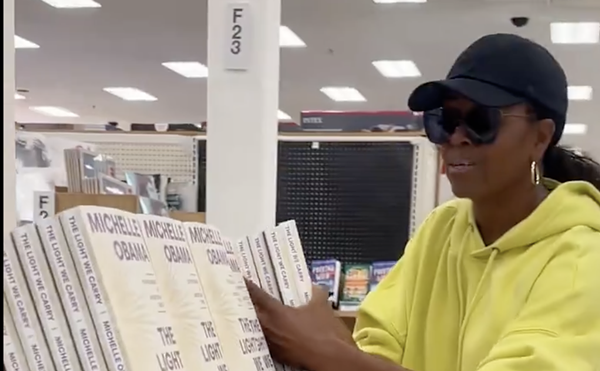William Shearburn Gallery
ROBIN MUREZ: PODS
Laumeier Sculpture Park
Barry Leibman's Mozart Suite, on view at the William Shearburn Gallery until Nov. 28, is a heady, visually intoxicating ensemble of seven abstract paintings, each inspired by music. Like a musical ensemble, these pieces work beautifully together. Hanging on all four walls of the skylighted gallery, they produce visual dialogues with one another, with colors answering each other across the room, and the more restless pieces appearing calmed by the more contemplative ones.
But taken individually, they are works of tremendous strength and complexity. Each painting represents the artist's visual transcription of a Mozart movement from a symphony, a sonata or a concerto. The pulsating variety of the painted surfaces disguises the strict consistency of their formats: Each painting is mixed-media (mainly oil stick) on panel, 45.5 inches high by 40 inches wide, with one triptych and two diptychs among the group.
These paintings aren't literal transcriptions of music, of course. They're translations of the music's visual suggestions, which have clearly evolved over time (Leibman has been working on this series for three years). The process of evolution shows in the surfaces, which are heavily worked, with areas of crusty impasto and bodies of color emerging from countless layers of paint.
Titles are derived from the musical pieces themselves ("String Quartet in D Major K593 1st Movement"), and unless you study Mozart, they probably won't immediately bring a tune to mind. I found that to be a good thing. Instead of trying to read the paintings as literal indexes of the music, I was able to contemplate the rich relationships of color and form within each painting.
Mozart's music ranges the spectrum from moody to effervescent, and that same range is found in Leibman's paintings. "String Quartet in D... " is somber, with a large blood-red form anchoring the painting, while busy intertwining lines of red and black float above it. Its neighbor to the left, "String Quartet Number 17... " is a joyful combination of intense colors, with a lapis-blue ground overlaid with scrawls in green, yellow and blue. These busy scrawls find their way into several of the paintings, providing active counterpoints to broad fields of color, balancing the compositions in a way that is very suggestive of music.
Some of these paintings evoke the tranquility of Mark Rothko's works; some, with their scrawls, bring Cy Twombly to mind, and you may be tempted to read those scrawls as marks belonging to a strange language. In a sense, these paintings are writing in another language, the language of pure, abstract form and color, the visual traces of the invisible art of music.
Anyone who has lived through elementary school probably remembers the wonder of that day when the subject was minerals and you got to discover brilliant, delicate purple fluorite crystals, nestled deep within a pocked gray, utterly unremarkable rock shell. That something so unrefined as that rock could hold something as fine as those crystals is a simple fact of nature, but it still has the power to amaze.
Robin Murez captures some of that wonder in her Pods, a series of blown- and molded-glass pieces produced during her residency this year at Laumeier Sculpture Park. Placed on pedestals scattered through the Artisan Gallery, the pods are remarkably, and even disappointingly, consistent. All smallish in scale, the open-mouthed creatures look a bit like beached blowfish (they're even placed on sand).
There is that moment of wonder, however, that comes from looking at the coarse gray and black exteriors, then discovering the interiors, where the glass is smooth and iridescent, with gold, silver and myriad other colored highlights. And resting inside the pods are colored glass "seeds" that look like magical pearls released from some kind of superoyster.
The glass pods are so visually appealing that they make natural pods, things like common hickories and buckeyes, seem sorry by comparison. But the glass objects manage to distill the beauty in the concept of the pod, the idea of containing and protecting the fragile and the precious. However, although no two pods are identical (the sizes are slightly different, the colors and textures vary somewhat), they are remarkably similar, and it would have been nice to see Murez explore the same concept but experiment with form to a greater degree.
Actually, Murez does experiment with this form on the grounds of the sculpture park, where she has placed five large, hollow concrete pods, big enough to climb into. Although coarser in materials and certainly not as pretty as the glass ones, the big pods do invite you to climb inside them and explore, I suppose, what it feels like to be a seed.
Also in the gallery are a series of Murez's glass Blades. These wonderful pieces are tall, jointed, tubular forms, some towering at 7 and 9 feet tall, like outsize reeds in a crystal forest. Of course they are extremely breakable, so they're cordoned off in the corners of the gallery, but that elementary schoolkid in me still wants to run through a whole forest of them. You can look even if you can't touch, and I recommend in particular a look at Blades.
Robin Murez's works are on display at Laumeier Sculpture Park through Jan. 17.




